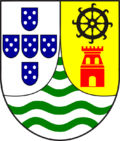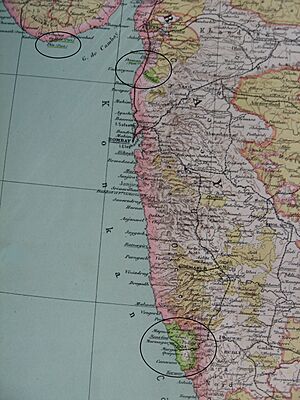List of governors of Portuguese India facts for kids
Quick facts for kids Viceroy of Portuguese India |
|
|---|---|
| Residence | Viceroy's House |
| Nominator | Prime Minister of Portugal |
| Appointer | Monarch of Portugal (1505–1910) President of Portugal (1910–1961) |
| Precursor | None |
| Formation | 12 September 1505 |
| First holder | Tristão da Cunha |
| Final holder | Manuel António Vassalo e Silva |
| Abolished | 19 December 1961 |
| Succession | Governor of Goa |
Portuguese India was a group of lands in India that were once ruled by Portugal. This rule began on September 12, 1505. It was seven years after the famous explorer Vasco da Gama found a sea route to India. The first Portuguese leader in India was a viceroy named Francisco de Almeida. He was based in Cochin.
For a long time, the name "India" included all Portuguese lands in the Indian Ocean. This stretched from Southern Africa to Southeast Asia. These areas were governed from Old Goa, which became the main city in 1510. Over time, Portugal's control in India became smaller. By 1844, it only included areas along the Konkan, Canara, and Malabar Coasts. Eventually, it was just the modern-day state of Goa and the area of Daman.
Portugal lost control of Dadra and Nagar Haveli in 1954. Then, in 1961, the Republic of India took over Goa. This ended over 450 years of Portuguese rule in parts of India. Portugal officially recognized this change in 1974.
Contents
Leaders of Portuguese India
The leaders of Portuguese India were called either "governors" or "viceroys." A "viceroy" was usually a high-ranking noble. The title of viceroy was formally stopped in 1774, but it was sometimes used again until 1835.
The First Leaders
The first person chosen to be a viceroy was Tristão da Cunha. However, he never actually took the job.
The first real governor and viceroy was Francisco de Almeida. He started his rule on September 12, 1505. He conquered areas like Kilwa and built forts in places like Cochin. He stayed in power until November 1509.
Afonso de Albuquerque became Governor and Captain-General in November 1509. He is famous for conquering important cities like Goa, Malacca, and Hormuz. He greatly expanded Portuguese control.
Another well-known leader was Vasco da Gama, the explorer who first found the sea route to India. He became the second viceroy in September 1524. Sadly, he died in Cochin just a few months later, in December 1524.
Changes in Leadership Roles
Sometimes, the Portuguese government tried to divide its territories into different parts. For example, in 1508, King Manuel I planned to split the empire into three main areas. One would cover East Africa and Arabia, another would cover the Indian coast, and a third would cover Southeast Asia. However, this plan didn't work out, and Afonso de Albuquerque ended up governing the whole area.
Around 1570, King Sebastian of Portugal tried a similar plan. He wanted three separate governments: one in East Africa, one in Goa (for India), and one in Malacca (for Southeast Asia). This also didn't last long, and the main leadership remained in Goa.
The title of "Viceroy of Indies" was officially removed in 1771. It was replaced with "Captain-General." However, as you can see from the list of leaders, the title of viceroy was sometimes used again later.
Notable Leaders and Their Times
Over the centuries, many different people led Portuguese India. They faced challenges like wars, trade issues, and managing a large empire far from Portugal.
- João de Castro was a governor who later became the fourth viceroy in 1548. He died in Goa that same year.
- Luís de Ataíde served two terms as viceroy (1568-1571 and 1578-1581). He was in India when the King of Portugal died in battle, and he helped manage the colony during a difficult time for Portugal.
- After 1581, Portugal came under the rule of the Spanish Habsburg kings. The first viceroy appointed by the new Spanish-Portuguese king was Francisco de Mascarenhas.
- In the 17th century, leaders like Miguel de Noronha, conde de Linhares (1629-1635) and Filipe Mascarenhas (1644-1651) continued to govern.
- Sometimes, when a governor or viceroy died or was removed, a "Governing Council" would take over temporarily. These councils usually consisted of important officials like the Archbishop of Goa.
- The last Governor-General of Portuguese India was Manuel António Vassalo e Silva. He was in charge when India took over Goa in 1961, ending Portuguese rule.
See also



